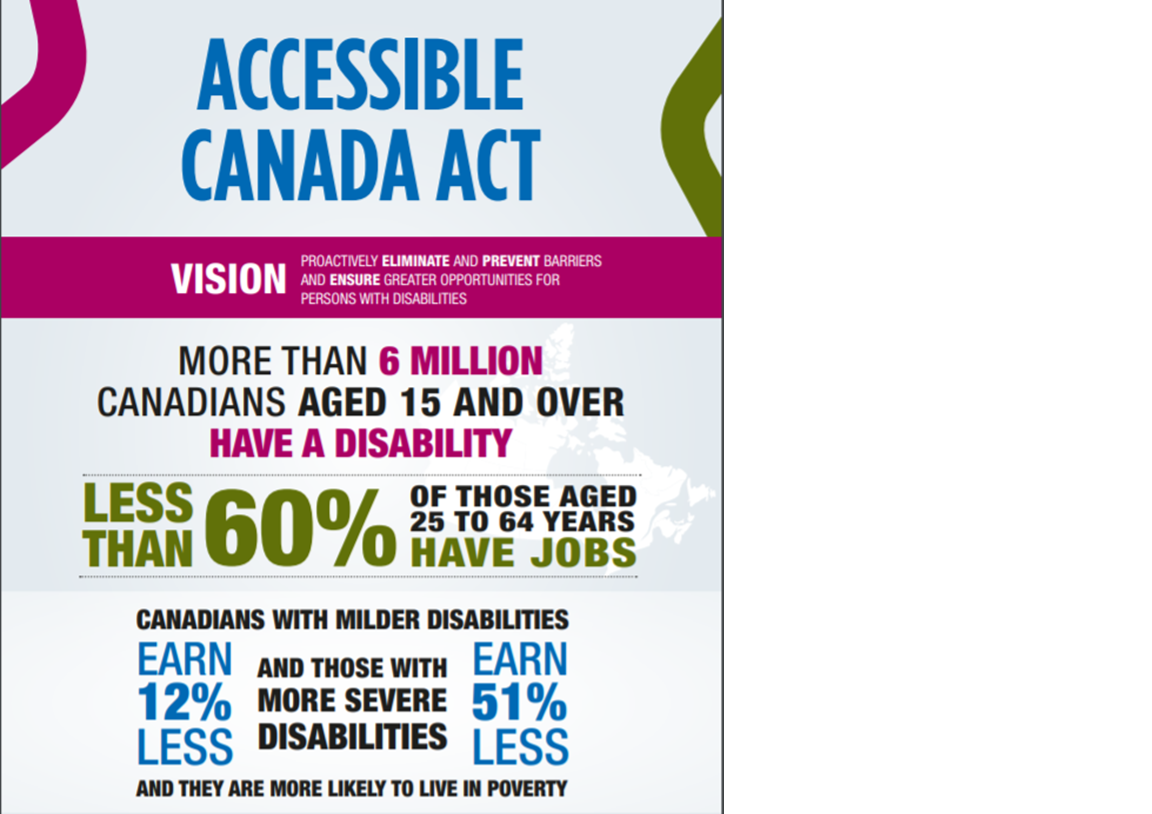What does an Accessible Canada mean to you?
“Nothing about us…without us”: the Accessible Canada Act will be implemented in partnership with persons with disabilities and the disability community.

Accessible Canada Act
Vision
Proactively eliminate and prevent barriers and ensure greater opportunities for persons with disabilities.
Accessibility in Canada is about creating communities, workplaces and services that enable everyone to participate fully in society without barriers.
According to the 2017 Canadian Survey on Disability, more than 6 million Canadians aged 15 and over (22% of the population) identify as having a disability, and it is expected actual numbers are likely higher. Only 59% of Canadians with disabilities aged 25 to 64 are employed compared to 80% of Canadians without disabilities. Persons with disabilities earn less than Canadians without disabilities (12% less for those with milder disabilities and 51% less for those with more severe disabilities) and are more likely to live in poverty.
The advocacy of disability stakeholders and organizations in Canada has been critical to promoting the rights of persons with disabilities. The Government of Canada is building on this legacy to improve accessibility and promote inclusion for everyone in Canada.
The Accessible Canada Act
With the adoption of An Act to Ensure a Barrier-free Canada (Accessible Canada Act), the Government of Canada is fulfilling its mandate promise to introduce new accessibility legislation. The Government of Canada will continue to work with persons with disabilities and the disability community, as well as with provinces and territories, towards the realization of an accessible Canada.
This legislation will benefit everyone in Canada, especially persons with disabilities, by helping to create a barrier-free Canada through the proactive identification, removal and prevention of barriers to accessibility wherever Canadians interact with areas under federal jurisdiction. The Accessible Canada Act provides for the development of accessibility standards and gives the Government of Canada the authority to work with stakeholders and persons with disabilities to create new accessibility regulations that will apply to sectors within the federal jurisdiction, such as banking, telecommunications, transportation industries and the Government of Canada itself. These new regulations will set out requirements for organizations to follow in order to identify, remove and prevent barriers to accessibility. The Accessible Canada Act will also put in place compliance and enforcement measures, as well as an accessibility complaints mechanism.
To support the development of the Accessible Canada Act, the Government of Canada consulted with Canadians, from July 2016 to February 2017, to find out what an accessible Canada means to them. The report, “Creating new national accessibility legislation: What we learned from Canadians,” released in May 2017, shares the key findings of these consultations.
During the consultations, Canadians identified the following key areas where the Government of Canada should focus its efforts under the legislation: programs and service delivery, employment, the built environment, information and communications technology, procurement and transportation. During the parliamentary process, the disability community identified communications as another key priority area and it was added to the list.
The Accessible Canada Act will help to change the way that the Government of Canada and organizations within federal jurisdiction address disability and accessibility and interact with Canadians.
View the accessible summary of the proposed Accessible Canada Act, as tabled on June 20, 2018, in the format that works best for you.

More than 6 million Canadians aged 15 and over have a disability.
Less than 60% of those aged 25 to 64 years have jobs.
Canadians with milder disabilities earn 12% less and those with more severe disabilities earn 51% less and they are more likely to live in poverty.
“Nothing without us”: the Accessible Canada Act will be implemented in partnership with persons with disabilities and the disability community.
